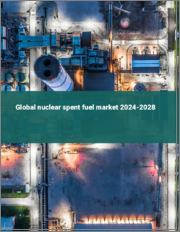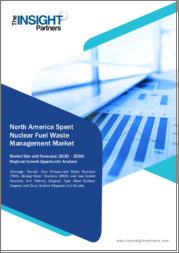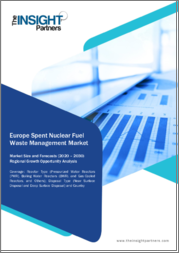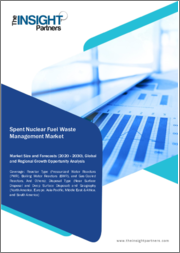
|
시장보고서
상품코드
1365583
핵폐기물 관리 시장 : 폐기물 유형별, 원자로 유형별, 폐기 방법별 : 기회 분석 및 산업 예측(2023-2032년)Nuclear Waste Management Market By Waste Type, By Reactor Type, By Disposal Method : Global Opportunity Analysis and Industry Forecast, 2023-2032 |
||||||
Allied Market Research가 발행한 핵폐기물 관리 시장 보고서에 따르면, 핵폐기물 관리 시장은 2022년 48억 달러로 평가되며 2023년부터 2032년까지 CAGR 1.9%로 성장해 2032년에는 57억 달러에 달할 것으로 예상됩니다.

방사성폐기물은 원자력 발전, 원자력 연구, 핵무기 제조 등 다양한 원자력 활동에서 발생하는 제품별, 잔류물을 말합니다. 핵반응이나 방사성 물질에 노출된 결과 방사성 물질이 된 물질로 구성되어 있습니다. 방사성 폐기물은 일반적으로 사용 후 핵연료, 오염된 장비, 폐로된 원자력 시설의 구조물, 방사성 물질로 오염된 다양한 액체, 고체, 기체 등 다양한 물질이 포함됩니다.
방사성 폐기물의 방사능은 그 기원, 구성, 연대에 따라 달라집니다. 어떤 방사성 폐기물은 오랜 기간 동안 높은 방사능을 유지하는 반면, 어떤 방사성 폐기물은 시간이 지남에 따라 방사능이 빠르게 감소하는 경우도 있습니다. 핵폐기물 관리에는 인체와 환경에 대한 위험을 최소화하는 방식으로 방사성 폐기물을 취급, 저장, 처리 및 폐기하는 전략과 기술이 포함됩니다. 여기에는 폐기물 분류, 폐기물 최소화, 현장 보관, 운송, 처리 및 조정, 지층 처분, 모니터링, 규제 당국의 감시 등의 업무가 포함됩니다. 일부 첨단 원자로는 핵반응을 통해 수명이 긴 방사성 동위원소를 수명이 짧거나 안정적인 동위원소로 변환하는 과정인 폐기물 핵변환의 잠재력을 가지고 있습니다. 이를 통해 방사성 폐기물과 관련된 장기적인 위험을 더욱 줄일 수 있습니다.
이러한 첨단 원자로 기술의 개발과 도입은 핵폐기물 관리 산업에 기회를 가져다줍니다. 이러한 기술 혁신은 원자력 발전의 효율성과 지속가능성을 개선하는 동시에 방사성 폐기물 문제를 해결할 수 있는 잠재력을 가지고 있습니다. 산업계는 폐기물 감소, 처리 및 처분 프로세스를 최적화하고 첨단 원자로의 특성에 맞는 새로운 폐기물 관리 접근 방식과 기술을 모색할 것입니다.
방사성폐기물 관리 관행에 대한 대중의 인식과 수용에는 문제가 있습니다. 폐기물 시설 주변 지역 사회는 방사성 폐기물 운송 및 저장 중 사고와 관련된 위험을 인식하고 있기 때문에 우려와 반대를 표명할 수 있습니다. 이해관계자와의 효과적인 소통, 투명성, 참여를 통해 이러한 우려를 해소하는 것은 신뢰를 구축하고 이해를 증진하며 방사성 폐기물의 안전하고 책임감 있는 관리를 보장하는 데 필수적입니다. 첨단 원자로 설계 및 개념 등 원자로 기술의 발전은 방사성 폐기물을 연료 공급원으로 활용할 수 있는 기회를 제공합니다. 일부 첨단 원자로 기술은 특정 유형의 방사성 폐기물을 연료로 사용할 수 있어 에너지 생산량을 늘리고 폐기물 비축을 최소화할 수 있습니다. 방사성 폐기물 재처리는 플루토늄이나 우라늄과 같은 귀중한 물질을 추출하여 핵연료 생산에 재사용할 수 있는 기회를 제공합니다. 이러한 물질의 회수 및 재활용은 방사성 폐기물의 자원 활용을 극대화하고 추가 채굴의 필요성을 감소시켜 핵연료 사이클의 지속가능성을 촉진합니다.
핵폐기물 관리는 국제 협력과 지식 공유의 기회를 제공합니다. 선진적인 핵폐기물 관리를 실천하는 국가들은 자국 내 폐기물 관리 인프라를 개발하거나 강화하려는 국가들과 협력합니다. 모범 사례, 기술 전문 지식 및 교훈을 공유하면 세계 폐기물 관리 능력을 향상시킬 수 있습니다. 핵폐기물 관리는 전문 인프라, 폐기물 처리 시설, R&D 센터 설립을 통해 경제 발전에 기여합니다. 고용 기회를 창출하고, 기술 혁신을 촉진하며, 폐기물 관리 시설이 위치한 지역의 지역 경제를 활성화합니다.
핵폐기물 관리 시장 규모는 폐기물 유형, 원자로 유형, 폐기 방법, 지역을 기준으로 조사됩니다. 폐기물 유형에 따라 핵폐기물 관리 시장은 저준위 폐기물, 중준위 폐기물, 고준위 폐기물로 나뉩니다. 고준위 폐기물 부문은 2022년 핵폐기물 관리 시장 점유율을 독점했습니다. 원자로 유형별로는 가압수형 원자로, 비등수형 원자로, 가스냉각식 원자로, 가압중수로로 구분됩니다. 가압경수로(PWR) 부문은 조사 기간 동안 시장 점유율이 확대될 것으로 예상되며, PWR은 세계에서 가장 일반적인 원자로 유형으로 세계 원자력 발전 용량의 약 3분의 2를 차지합니다. 그 결과, PWR에서 발생하는 방사성 폐기물의 양은 다른 원자로 유형에 비해 많으며, 이는 효과적이고 효율적인 폐기물 관리 시스템에 대한 큰 수요를 창출하고 있습니다. 폐기 방식에 따라 시장은 소각, 저장, 심지층 처분 및 기타로 분류되며, 심지층 처분 부문이 2022년 시장 점유율을 독점할 것으로 예상됩니다. 지역별로는 북미, 유럽, 아시아태평양, 라틴아메리카, 중동 및 아프리카에서 핵폐기물 관리 시장을 분석했으며, 2022년 핵폐기물 관리 시장 점유율은 유럽이 압도적으로 높았고, 아시아태평양이 그 뒤를 이었습니다.
방사성폐기물 관리 산업에서 활동하는 주요 기업으로는 Augean, Perma-Fix Environmental Services, Inc. 미국 Ecology, Inc, Veolia, Bechtel Corporation, Waste Control Specialists LLC, JGC Holdings Corporation, Energy Solutions, Inc.
이 보고서는 시장 동력에 대한 이해를 높이기 위해 시장 성장 촉진요인, 억제요인 및 시장 기회를 설명합니다. 이 보고서는 또한 주요 투자 분야를 강조합니다. 또한 Porter's Five Forces 분석을 통해 업계의 경쟁 시나리오와 각 이해관계자의 역할을 이해할 수 있도록 했습니다. 이 보고서는 주요 시장 진입자들이 시장에서 발판을 마련하기 위해 채택한 전략을 소개합니다. 또한 시장 점유율을 확대하고 업계에서 치열한 경쟁을 유지하기 위한 주요 기업의 경쟁 구도를 강조합니다.
목차
제1장 서론
제2장 주요 요약
제3장 시장 개요
- 시장 정의와 범위
- 주요 조사 결과
- 영향요인
- 주요 투자 기회
- Porter의 Five Forces 분석
- 시장 역학
- 성장 촉진요인
- 성장 억제요인
- 기회
- 시장에 대한 COVID-19의 영향 분석
- 밸류체인 분석
- 특허 상황
- 규제 가이드라인
제4장 핵폐기물 관리 시장 : 폐기물 유형별
- 개요
- 저레벨 폐기물
- 중간레벨 폐기물
- 고레벨 폐기물
제5장 핵폐기물 관리 시장 : 원자로 유형별
- 개요
- 가압수형 원자로
- 비등수형 원자로
- 가스 냉각형 원자로
- 가압 중수형 원자로
제6장 핵폐기물 관리 시장 : 폐기 방법별
- 개요
- 소각
- 저장
- 심지층 처분
- 기타
제7장 핵폐기물 관리 시장 : 지역별
- 개요
- 북미
- 미국
- 캐나다
- 멕시코
- 유럽
- 독일
- 영국
- 프랑스
- 러시아
- 우크라이나
- 기타
- 아시아태평양
- 중국
- 일본
- 인도
- 한국
- 호주
- 기타
- 라틴아메리카/중동 및 아프리카
- 브라질
- 사우디아라비아
- 남아프리카공화국
- 기타
제8장 경쟁 구도
- 서론
- 주요 성공 전략
- 주요 10개 기업의 제품 매핑
- 경쟁 대시보드
- 경쟁 히트맵
- 주요 기업의 포지셔닝, 2022년
제9장 기업 개요
- Augean
- Perma-Fix Environmental Services, Inc.
- Svensk Karnbranslehantering AB
- Stericycle, Inc.
- US Ecology, Inc.
- Veolia Environnement SA.
- Bechtel Corporation
- Waste Control Specialists LLC(WCS)
- EnergySolutions
- JGC HOLDINGS CORPORATION
According to a new report published by Allied Market Research, titled, "Nuclear Waste Management Market," The nuclear waste management market was valued at $4.8 billion in 2022, and is estimated to reach $5.7 billion by 2032, growing at a CAGR of 1.9% from 2023 to 2032.
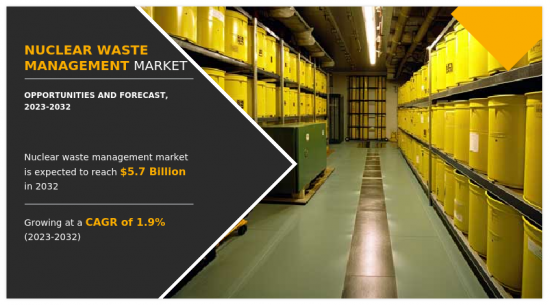
Nuclear waste refers to the byproducts and residues generated from various nuclear activities, including nuclear power generation, nuclear research, and nuclear weapons production. It consists of materials that have become radioactive as a result of exposure to nuclear reactions or radioactive substances. Nuclear waste typically includes a range of materials, such as spent nuclear fuel, contaminated equipment, structural materials from decommissioned nuclear facilities, and various liquids, solids, or gases that have been contaminated with radioactive substances.
The radioactivity of nuclear waste varies depending on its origin, composition, and age. Some nuclear waste remains highly radioactive for long periods, while the radioactivity of other types decreases more rapidly over time. The management of nuclear waste involves strategies and techniques to handle, store, treat, and dispose of it in a manner that minimizes the risks to human health and the environment. This includes practices such as waste categorization, waste minimization, on-site storage, transportation, treatment & conditioning, geological disposal, monitoring, and regulatory oversight. Some advanced reactors have the potential for waste transmutation, a process that transforms long-lived radioactive isotopes into shorter-lived or stable isotopes through nuclear reactions. This further reduces the long-term hazards associated with nuclear waste.
The development and deployment of these advanced reactor technologies present opportunities for the nuclear waste management industry. These innovations have the potential to improve the efficiency and sustainability of nuclear power generation while also addressing the challenges of nuclear waste. The industry explores new waste management approaches and technologies that align with the characteristics of advanced reactors, optimizing waste reduction, treatment, and disposal processes.
Public perception and acceptance of nuclear waste management practices present challenges. Communities near waste facilities may express concerns and opposition due to perceived risks associated with accidents during the transportation and storage of nuclear waste. Addressing these concerns through effective communication, transparency, and engagement with stakeholders is essential to build trust, foster understanding, and ensure the safe and responsible management of nuclear waste. Advances in reactor technology, such as advanced reactor designs and concepts, provide opportunities for utilizing nuclear waste as a fuel source. Some advanced reactor technologies are potentially using certain types of nuclear waste as fuel, leading to increased energy generation and minimizing waste stockpiles. Reprocessing of nuclear waste offers an opportunity to extract valuable materials, such as plutonium and uranium, for reuse in nuclear fuel production. By recovering and recycling these materials, the resource utilization of nuclear waste is maximized, reducing the need for additional mining and promoting sustainability in the nuclear fuel cycle.
Nuclear waste management offers opportunities for international collaboration and knowledge sharing. Countries with advanced nuclear waste management practices collaborate with those seeking to develop or enhance their own waste management infrastructure. Sharing best practices, technical expertise, and lessons learned lead to improved waste management capabilities globally. Nuclear waste management contributes to economic development through the establishment of specialized infrastructure, waste treatment facilities, and research and development centers. It creates job opportunities, fosters technological innovation, and stimulates local economies in areas where waste management facilities are located.
The nuclear waste management market size is studied on the basis of waste type, reactor type, disposal method, and region. By waste type, the nuclear waste management market is divided into low-level waste, intermediate-level waste, and high-level waste. The high-level waste segment dominated the nuclear waste management market share in 2022. By reactor type, the market is categorized into pressurized water reactors, boiling water reactors, gas-cooled reactors, and pressurized heavy water reactors. The pressurized water reactor (PWR) segment is expected to witness a larger market share in the study period. PWRs are the most common type of nuclear reactor across the globe, accounting for around two-thirds of the global nuclear power capacity. As a result, the volume of nuclear waste generated by PWRs is also higher than other reactor types, creating a significant demand for effective and efficient waste management systems. Depending on the disposal method, the market is classified into incineration, storage, deep geological disposal, and others. The deep geological disposal segment dominated the market share for 2022. By region, the nuclear waste management market analysis is done across North America, Europe, Asia-Pacific, and LAMEA (Latin America, the Middle East, and Africa). Europe dominated the nuclear waste management market share for 2022 followed by Asia-Pacific.
The major players operating in the nuclear waste management industry are Augean, Perma-Fix Environmental Services, Inc., Swedish Nuclear Fuel and Waste Management Company, Stericycle, Inc., US Ecology, Inc., Veolia, Bechtel Corporation, Waste Control Specialists LLC, JGC Holdings Corporation, and Energy Solutions, Inc
The growth drivers, restraints, and opportunities are explained in the report to better understand the market dynamics. This report further highlights the key areas of investment. In addition, it includes Porter's five forces analysis to understand the competitive scenario of the industry and the role of each stakeholder. The report features strategies adopted by key market players to maintain their foothold in the market. Furthermore, it highlights the competitive landscape of key players to increase their market share and sustain the intense competition in the industry.
Key Benefits For Stakeholders
- This report provides a quantitative analysis of the market segments, current trends, estimations, and dynamics of the nuclear waste management market analysis from 2022 to 2032 to identify the prevailing nuclear waste management market opportunities.
- The market research is offered along with information related to key drivers, restraints, and opportunities.
- Porter's five forces analysis highlights the potency of buyers and suppliers to enable stakeholders make profit-oriented business decisions and strengthen their supplier-buyer network.
- In-depth analysis of the nuclear waste management market segmentation assists to determine the prevailing market opportunities.
- Major countries in each region are mapped according to their revenue contribution to the global market.
- Market player positioning facilitates benchmarking and provides a clear understanding of the present position of the market players.
- The report includes the analysis of the regional as well as global nuclear waste management market trends, key players, market segments, application areas, and market growth strategies.
Additional benefits you will get with this purchase are:
- Quarterly Update and* (only available with a corporate license, on listed price)
- 5 additional Company Profile of client Choice pre- or Post-purchase, as a free update.
- Free Upcoming Version on the Purchase of Five and Enterprise User License.
- 16 analyst hours of support* (post-purchase, if you find additional data requirements upon review of the report, you may receive support amounting to 16 analyst hours to solve questions, and post-sale queries)
- 15% Free Customization* (in case the scope or segment of the report does not match your requirements, 20% is equivalent to 3 working days of free work, applicable once)
- Free data Pack on the Five and Enterprise User License. (Excel version of the report)
- Free Updated report if the report is 6-12 months old or older.
- 24-hour priority response*
- Free Industry updates and white papers.
Possible Customization with this report (with additional cost and timeline talk to the sales executive to know more)
- Additional company profiles with specific to client's interest
- Additional country or region analysis- market size and forecast
- Criss-cross segment analysis- market size and forecast
- Historic market data
- Import Export Analysis/Data
- SWOT Analysis
Key Market Segments
By Waste Type
- High Level Waste
- Low Level Waste
- Intermediate Level Waste
By Reactor Type
- Pressurized Water Reactor
- Boiling Water Reactor
- Gas Cooled Reactor
- Pressurized Heavy Water Reactor
By Disposal Method
- Incineration
- Storage
- Deep Geological Disposal
- Others
By Region
- North America
- U.S.
- Canada
- Mexico
- Europe
- Germany
- UK
- France
- Russia
- Ukraine
- Rest of Europe
- Asia-Pacific
- China
- Japan
- India
- South Korea
- Australia
- Rest of Asia-Pacific
- LAMEA
- Brazil
- Saudi Arabia
- South Africa
- Rest of LAMEA
Key Market Players:
- Augean
- Bechtel Corporation
- EnergySolutions
- JGC HOLDINGS CORPORATION
- Perma-Fix Environmental Services, Inc.
- Stericycle, Inc.
- Svensk Karnbranslehantering AB
- US Ecology, Inc.
- Veolia Environnement SA.
- Waste Control Specialists LLC (WCS)
TABLE OF CONTENTS
CHAPTER 1: INTRODUCTION
- 1.1. Report description
- 1.2. Key market segments
- 1.3. Key benefits to the stakeholders
- 1.4. Research Methodology
- 1.4.1. Primary research
- 1.4.2. Secondary research
- 1.4.3. Analyst tools and models
CHAPTER 2: EXECUTIVE SUMMARY
- 2.1. CXO Perspective
CHAPTER 3: MARKET OVERVIEW
- 3.1. Market definition and scope
- 3.2. Key findings
- 3.2.1. Top impacting factors
- 3.2.2. Top investment pockets
- 3.3. Porter's five forces analysis
- 3.3.1. Low bargaining power of suppliers
- 3.3.2. Low threat of new entrants
- 3.3.3. Low threat of substitutes
- 3.3.4. Low intensity of rivalry
- 3.3.5. Low bargaining power of buyers
- 3.4. Market dynamics
- 3.4.1. Drivers
- 3.4.1.1. Radioactive hazard mitigation and environment protection
- 3.4.1.2. Volume reduction and long-term solutions
- 3.4.1.3. Resource conservation and energy generation
- 3.4.1. Drivers
- 3.4.2. Restraints
- 3.4.2.1. Environmental risk and radioactive hazards
- 3.4.2.2. Rise in awareness and public perception
- 3.4.2.3. High cost and stringent regulations
- 3.4.3. Opportunities
- 3.4.3.1. Technological advancements for energy conservation
- 3.4.3.2. Economic development
- 3.5. COVID-19 Impact Analysis on the market
- 3.6. Value Chain Analysis
- 3.7. Patent Landscape
- 3.8. Regulatory Guidelines
CHAPTER 4: NUCLEAR WASTE MANAGEMENT MARKET, BY WASTE TYPE
- 4.1. Overview
- 4.1.1. Market size and forecast
- 4.2. Low Level Waste
- 4.2.1. Key market trends, growth factors and opportunities
- 4.2.2. Market size and forecast, by region
- 4.2.3. Market share analysis by country
- 4.3. Intermediate Level Waste
- 4.3.1. Key market trends, growth factors and opportunities
- 4.3.2. Market size and forecast, by region
- 4.3.3. Market share analysis by country
- 4.4. High Level Waste
- 4.4.1. Key market trends, growth factors and opportunities
- 4.4.2. Market size and forecast, by region
- 4.4.3. Market share analysis by country
CHAPTER 5: NUCLEAR WASTE MANAGEMENT MARKET, BY REACTOR TYPE
- 5.1. Overview
- 5.1.1. Market size and forecast
- 5.2. Pressurized Water Reactor
- 5.2.1. Key market trends, growth factors and opportunities
- 5.2.2. Market size and forecast, by region
- 5.2.3. Market share analysis by country
- 5.3. Boiling Water Reactor
- 5.3.1. Key market trends, growth factors and opportunities
- 5.3.2. Market size and forecast, by region
- 5.3.3. Market share analysis by country
- 5.4. Gas Cooled Reactor
- 5.4.1. Key market trends, growth factors and opportunities
- 5.4.2. Market size and forecast, by region
- 5.4.3. Market share analysis by country
- 5.5. Pressurized Heavy Water Reactor
- 5.5.1. Key market trends, growth factors and opportunities
- 5.5.2. Market size and forecast, by region
- 5.5.3. Market share analysis by country
CHAPTER 6: NUCLEAR WASTE MANAGEMENT MARKET, BY DISPOSAL METHOD
- 6.1. Overview
- 6.1.1. Market size and forecast
- 6.2. Incineration
- 6.2.1. Key market trends, growth factors and opportunities
- 6.2.2. Market size and forecast, by region
- 6.2.3. Market share analysis by country
- 6.3. Storage
- 6.3.1. Key market trends, growth factors and opportunities
- 6.3.2. Market size and forecast, by region
- 6.3.3. Market share analysis by country
- 6.4. Deep Geological Disposal
- 6.4.1. Key market trends, growth factors and opportunities
- 6.4.2. Market size and forecast, by region
- 6.4.3. Market share analysis by country
- 6.5. Others
- 6.5.1. Key market trends, growth factors and opportunities
- 6.5.2. Market size and forecast, by region
- 6.5.3. Market share analysis by country
CHAPTER 7: NUCLEAR WASTE MANAGEMENT MARKET, BY REGION
- 7.1. Overview
- 7.1.1. Market size and forecast By Region
- 7.2. North America
- 7.2.1. Key trends and opportunities
- 7.2.2. Market size and forecast, by Waste Type
- 7.2.3. Market size and forecast, by Reactor Type
- 7.2.4. Market size and forecast, by Disposal Method
- 7.2.5. Market size and forecast, by country
- 7.2.5.1. U.S.
- 7.2.5.1.1. Key market trends, growth factors and opportunities
- 7.2.5.1.2. Market size and forecast, by Waste Type
- 7.2.5.1.3. Market size and forecast, by Reactor Type
- 7.2.5.1.4. Market size and forecast, by Disposal Method
- 7.2.5.2. Canada
- 7.2.5.2.1. Key market trends, growth factors and opportunities
- 7.2.5.2.2. Market size and forecast, by Waste Type
- 7.2.5.2.3. Market size and forecast, by Reactor Type
- 7.2.5.2.4. Market size and forecast, by Disposal Method
- 7.2.5.3. Mexico
- 7.2.5.3.1. Key market trends, growth factors and opportunities
- 7.2.5.3.2. Market size and forecast, by Waste Type
- 7.2.5.3.3. Market size and forecast, by Reactor Type
- 7.2.5.3.4. Market size and forecast, by Disposal Method
- 7.3. Europe
- 7.3.1. Key trends and opportunities
- 7.3.2. Market size and forecast, by Waste Type
- 7.3.3. Market size and forecast, by Reactor Type
- 7.3.4. Market size and forecast, by Disposal Method
- 7.3.5. Market size and forecast, by country
- 7.3.5.1. Germany
- 7.3.5.1.1. Key market trends, growth factors and opportunities
- 7.3.5.1.2. Market size and forecast, by Waste Type
- 7.3.5.1.3. Market size and forecast, by Reactor Type
- 7.3.5.1.4. Market size and forecast, by Disposal Method
- 7.3.5.2. UK
- 7.3.5.2.1. Key market trends, growth factors and opportunities
- 7.3.5.2.2. Market size and forecast, by Waste Type
- 7.3.5.2.3. Market size and forecast, by Reactor Type
- 7.3.5.2.4. Market size and forecast, by Disposal Method
- 7.3.5.3. France
- 7.3.5.3.1. Key market trends, growth factors and opportunities
- 7.3.5.3.2. Market size and forecast, by Waste Type
- 7.3.5.3.3. Market size and forecast, by Reactor Type
- 7.3.5.3.4. Market size and forecast, by Disposal Method
- 7.3.5.4. Russia
- 7.3.5.4.1. Key market trends, growth factors and opportunities
- 7.3.5.4.2. Market size and forecast, by Waste Type
- 7.3.5.4.3. Market size and forecast, by Reactor Type
- 7.3.5.4.4. Market size and forecast, by Disposal Method
- 7.3.5.5. Ukraine
- 7.3.5.5.1. Key market trends, growth factors and opportunities
- 7.3.5.5.2. Market size and forecast, by Waste Type
- 7.3.5.5.3. Market size and forecast, by Reactor Type
- 7.3.5.5.4. Market size and forecast, by Disposal Method
- 7.3.5.6. Rest of Europe
- 7.3.5.6.1. Key market trends, growth factors and opportunities
- 7.3.5.6.2. Market size and forecast, by Waste Type
- 7.3.5.6.3. Market size and forecast, by Reactor Type
- 7.3.5.6.4. Market size and forecast, by Disposal Method
- 7.4. Asia-Pacific
- 7.4.1. Key trends and opportunities
- 7.4.2. Market size and forecast, by Waste Type
- 7.4.3. Market size and forecast, by Reactor Type
- 7.4.4. Market size and forecast, by Disposal Method
- 7.4.5. Market size and forecast, by country
- 7.4.5.1. China
- 7.4.5.1.1. Key market trends, growth factors and opportunities
- 7.4.5.1.2. Market size and forecast, by Waste Type
- 7.4.5.1.3. Market size and forecast, by Reactor Type
- 7.4.5.1.4. Market size and forecast, by Disposal Method
- 7.4.5.2. Japan
- 7.4.5.2.1. Key market trends, growth factors and opportunities
- 7.4.5.2.2. Market size and forecast, by Waste Type
- 7.4.5.2.3. Market size and forecast, by Reactor Type
- 7.4.5.2.4. Market size and forecast, by Disposal Method
- 7.4.5.3. India
- 7.4.5.3.1. Key market trends, growth factors and opportunities
- 7.4.5.3.2. Market size and forecast, by Waste Type
- 7.4.5.3.3. Market size and forecast, by Reactor Type
- 7.4.5.3.4. Market size and forecast, by Disposal Method
- 7.4.5.4. South Korea
- 7.4.5.4.1. Key market trends, growth factors and opportunities
- 7.4.5.4.2. Market size and forecast, by Waste Type
- 7.4.5.4.3. Market size and forecast, by Reactor Type
- 7.4.5.4.4. Market size and forecast, by Disposal Method
- 7.4.5.5. Australia
- 7.4.5.5.1. Key market trends, growth factors and opportunities
- 7.4.5.5.2. Market size and forecast, by Waste Type
- 7.4.5.5.3. Market size and forecast, by Reactor Type
- 7.4.5.5.4. Market size and forecast, by Disposal Method
- 7.4.5.6. Rest of Asia-Pacific
- 7.4.5.6.1. Key market trends, growth factors and opportunities
- 7.4.5.6.2. Market size and forecast, by Waste Type
- 7.4.5.6.3. Market size and forecast, by Reactor Type
- 7.4.5.6.4. Market size and forecast, by Disposal Method
- 7.5. LAMEA
- 7.5.1. Key trends and opportunities
- 7.5.2. Market size and forecast, by Waste Type
- 7.5.3. Market size and forecast, by Reactor Type
- 7.5.4. Market size and forecast, by Disposal Method
- 7.5.5. Market size and forecast, by country
- 7.5.5.1. Brazil
- 7.5.5.1.1. Key market trends, growth factors and opportunities
- 7.5.5.1.2. Market size and forecast, by Waste Type
- 7.5.5.1.3. Market size and forecast, by Reactor Type
- 7.5.5.1.4. Market size and forecast, by Disposal Method
- 7.5.5.2. Saudi Arabia
- 7.5.5.2.1. Key market trends, growth factors and opportunities
- 7.5.5.2.2. Market size and forecast, by Waste Type
- 7.5.5.2.3. Market size and forecast, by Reactor Type
- 7.5.5.2.4. Market size and forecast, by Disposal Method
- 7.5.5.3. South Africa
- 7.5.5.3.1. Key market trends, growth factors and opportunities
- 7.5.5.3.2. Market size and forecast, by Waste Type
- 7.5.5.3.3. Market size and forecast, by Reactor Type
- 7.5.5.3.4. Market size and forecast, by Disposal Method
- 7.5.5.4. Rest of LAMEA
- 7.5.5.4.1. Key market trends, growth factors and opportunities
- 7.5.5.4.2. Market size and forecast, by Waste Type
- 7.5.5.4.3. Market size and forecast, by Reactor Type
- 7.5.5.4.4. Market size and forecast, by Disposal Method
CHAPTER 8: COMPETITIVE LANDSCAPE
- 8.1. Introduction
- 8.2. Top winning strategies
- 8.3. Product Mapping of Top 10 Player
- 8.4. Competitive Dashboard
- 8.5. Competitive Heatmap
- 8.6. Top player positioning, 2022
CHAPTER 9: COMPANY PROFILES
- 9.1. Augean
- 9.1.1. Company overview
- 9.1.2. Key Executives
- 9.1.3. Company snapshot
- 9.1.4. Operating business segments
- 9.1.5. Product portfolio
- 9.1.6. Key strategic moves and developments
- 9.2. Perma-Fix Environmental Services, Inc.
- 9.2.1. Company overview
- 9.2.2. Key Executives
- 9.2.3. Company snapshot
- 9.2.4. Operating business segments
- 9.2.5. Product portfolio
- 9.2.6. Business performance
- 9.3. Svensk Karnbranslehantering AB
- 9.3.1. Company overview
- 9.3.2. Key Executives
- 9.3.3. Company snapshot
- 9.3.4. Operating business segments
- 9.3.5. Product portfolio
- 9.4. Stericycle, Inc.
- 9.4.1. Company overview
- 9.4.2. Key Executives
- 9.4.3. Company snapshot
- 9.4.4. Operating business segments
- 9.4.5. Product portfolio
- 9.4.6. Business performance
- 9.5. US Ecology, Inc.
- 9.5.1. Company overview
- 9.5.2. Key Executives
- 9.5.3. Company snapshot
- 9.5.4. Operating business segments
- 9.5.5. Product portfolio
- 9.6. Veolia Environnement SA.
- 9.6.1. Company overview
- 9.6.2. Key Executives
- 9.6.3. Company snapshot
- 9.6.4. Operating business segments
- 9.6.5. Product portfolio
- 9.6.6. Business performance
- 9.7. Bechtel Corporation
- 9.7.1. Company overview
- 9.7.2. Key Executives
- 9.7.3. Company snapshot
- 9.7.4. Operating business segments
- 9.7.5. Product portfolio
- 9.8. Waste Control Specialists LLC (WCS)
- 9.8.1. Company overview
- 9.8.2. Key Executives
- 9.8.3. Company snapshot
- 9.8.4. Operating business segments
- 9.8.5. Product portfolio
- 9.9. EnergySolutions
- 9.9.1. Company overview
- 9.9.2. Key Executives
- 9.9.3. Company snapshot
- 9.9.4. Operating business segments
- 9.9.5. Product portfolio
- 9.9.6. Key strategic moves and developments
- 9.10. JGC HOLDINGS CORPORATION
- 9.10.1. Company overview
- 9.10.2. Key Executives
- 9.10.3. Company snapshot
- 9.10.4. Operating business segments
- 9.10.5. Product portfolio
- 9.10.6. Business performance








